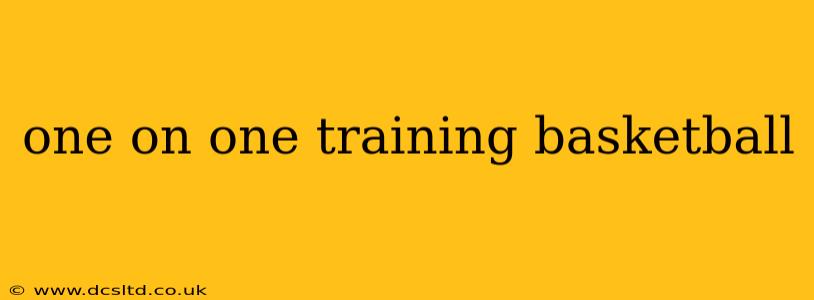One-on-one basketball training is a crucial element in developing a well-rounded player. It allows for focused improvement on individual skills, strategic thinking, and mental toughness. Whether you're a seasoned pro looking to refine your game or a beginner taking your first steps on the court, this comprehensive guide will explore the benefits, techniques, and strategies to maximize your one-on-one training sessions.
What are the benefits of one-on-one basketball training?
One-on-one training offers several advantages unavailable in team practices or scrimmages. It provides unparalleled opportunities for:
- Focused Skill Development: Unlike team practices, where focus is often split, one-on-one allows for dedicated work on specific skills like dribbling, shooting, footwork, and post moves. You can dedicate the entire session to perfecting a single aspect of your game.
- Personalized Coaching: A coach can provide immediate feedback and tailored drills to address individual weaknesses and capitalize on strengths. This personalized approach accelerates improvement.
- Increased Ball Handling Proficiency: Constant ball possession forces you to improve your ball-handling skills under pressure. You'll learn to protect the ball, change speeds, and create space effectively.
- Improved Decision-Making: The pressure of one-on-one forces rapid decision-making. You'll learn to assess your opponent, choose the right moves, and exploit their weaknesses.
- Enhanced Mental Toughness: One-on-one is a mental battle. Overcoming challenges and setbacks builds resilience and improves your competitive spirit.
What are some effective drills for one-on-one basketball training?
Effective one-on-one training involves a mix of fundamental drills and game-like scenarios. Here are a few examples:
- Finishing Drills: Focus on various finishes around the basket – layups, hook shots, floaters – from different angles and distances.
- Shooting Drills: Work on different shooting forms, focusing on consistency, arc, and follow-through. Incorporate game-like situations like shooting off the dribble or after a screen.
- Ball-Handling Drills: Practice dribbling drills like crossover, between-the-legs, and behind-the-back, emphasizing control and speed.
- Post Moves: If you're a post player, practice various moves like drop steps, up-and-unders, and turnaround jumpers.
- Defensive Drills: Practice footwork, stance, and hand positioning to improve your defensive skills. Focus on staying low, anticipating your opponent's moves, and maintaining good defensive posture.
How do I create a one-on-one basketball training plan?
A structured training plan is key to maximizing your progress. Consider these elements:
- Set Clear Goals: Identify specific areas you want to improve (e.g., shooting percentage, dribbling speed, defensive positioning).
- Schedule Regular Sessions: Consistency is crucial. Aim for regular sessions, even if they are short.
- Vary Drills: Avoid monotony by incorporating a mix of drills to challenge different skills.
- Track Progress: Monitor your progress by recording your performance in each session. This allows you to assess what's working and what needs adjustment.
- Seek Feedback: Regularly solicit feedback from your coach or training partner to identify areas for improvement.
What are some common mistakes to avoid in one-on-one basketball training?
- Neglecting Fundamentals: Don't rush into advanced moves before mastering the basics.
- Focusing Only on Offense: Develop both offensive and defensive skills for a well-rounded game.
- Lack of Structure: Without a plan, your sessions will be less effective.
- Ignoring Feedback: Be open to constructive criticism and use it to improve.
- Lack of Consistency: Regularity is essential for progress.
How can I find a one-on-one basketball trainer?
Finding a qualified trainer can significantly enhance your training experience. Consider searching online for trainers in your area, checking local gyms and sports centers, or asking for recommendations from other basketball players. Look for a trainer with experience and a proven track record.
What are some tips for improving my one-on-one game?
- Study your opponent: Observe their strengths and weaknesses to develop a strategy.
- Be patient: Progress takes time. Don't get discouraged by setbacks.
- Stay focused: Maintain concentration throughout the session.
- Have fun: Enjoy the process of learning and improving.
By consistently applying these strategies and incorporating the drills mentioned above, you'll significantly enhance your basketball skills and elevate your game to new heights. Remember that dedicated one-on-one training is an investment in your overall improvement as a player, both on and off the court.
